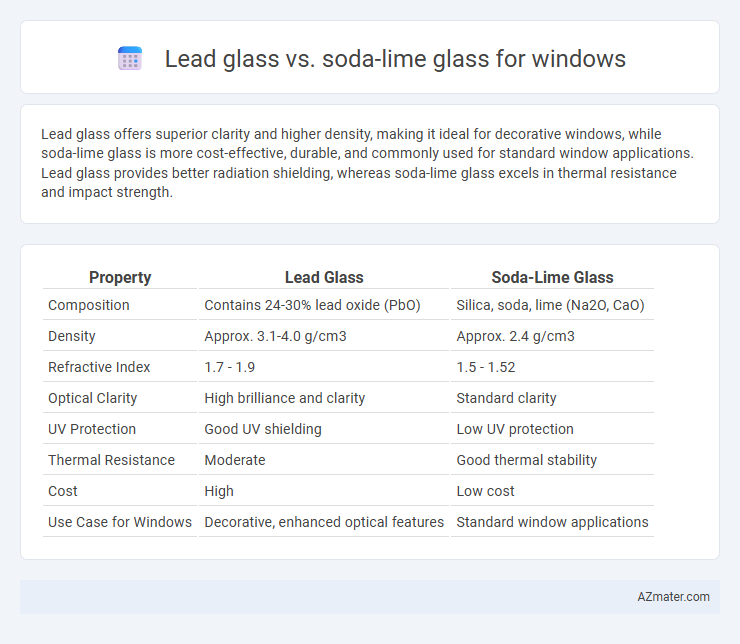Lead glass offers superior clarity and higher density, making it ideal for decorative windows, while soda-lime glass is more cost-effective, durable, and commonly used for standard window applications. Lead glass provides better radiation shielding, whereas soda-lime glass excels in thermal resistance and impact strength.
Table of Comparison
| Property | Lead Glass | Soda-Lime Glass |
|---|---|---|
| Composition | Contains 24-30% lead oxide (PbO) | Silica, soda, lime (Na2O, CaO) |
| Density | Approx. 3.1-4.0 g/cm3 | Approx. 2.4 g/cm3 |
| Refractive Index | 1.7 - 1.9 | 1.5 - 1.52 |
| Optical Clarity | High brilliance and clarity | Standard clarity |
| UV Protection | Good UV shielding | Low UV protection |
| Thermal Resistance | Moderate | Good thermal stability |
| Cost | High | Low cost |
| Use Case for Windows | Decorative, enhanced optical features | Standard window applications |
Introduction to Lead Glass and Soda-Lime Glass
Lead glass contains lead oxide, which enhances its density, refractive index, and brilliance, making it more decorative and suitable for specialized windows requiring superior clarity and light dispersion. Soda-lime glass, composed primarily of silica, soda, and lime, is the most common type used in standard window panes due to its affordability, durability, and ease of manufacture. The fundamental differences in chemical composition and physical properties determine their distinct applications and performance in window construction.
Chemical Composition Differences
Lead glass contains a high percentage of lead oxide, typically between 18-40%, which significantly increases its density and refractive index compared to soda-lime glass. Soda-lime glass primarily consists of silica (SiO2), sodium oxide (Na2O), and calcium oxide (CaO), making it less dense and more chemically stable for general window applications. The presence of lead oxide in lead glass enhances its optical clarity and radiation shielding properties but reduces its chemical durability compared to the more corrosion-resistant soda-lime glass.
Optical Properties Compared
Lead glass exhibits superior optical clarity and higher refractive index compared to soda-lime glass, resulting in enhanced light transmission and brilliance for window applications. Soda-lime glass, while more common and cost-effective, typically has lower dispersion and less resistance to environmental degradation affecting optical performance. The denser molecular structure of lead glass also provides better UV and radiation shielding, making it a preferred choice for specialty windows requiring superior optical properties.
Strength and Durability Assessment
Lead glass exhibits higher density and improved resistance to chemical corrosion compared to soda-lime glass, enhancing its durability in window applications. Its increased structural strength allows better impact resistance, making it suitable for environments requiring robust safety measures. Soda-lime glass, while more cost-effective, is more prone to scratches and thermal stress, limiting its longevity under harsh conditions.
Thermal Properties and Insulation
Lead glass offers superior thermal insulation due to its higher density and lower thermal conductivity compared to soda-lime glass, making it more effective at reducing heat transfer in windows. Soda-lime glass, commonly used in standard windows, has higher thermal conductivity and poorer insulating properties, resulting in less energy efficiency. Choosing lead glass improves thermal performance by minimizing heat loss and enhancing overall indoor temperature regulation.
Safety and Health Considerations
Lead glass contains lead oxide, which enhances its density and radiation shielding but poses health risks if damaged or improperly disposed of, potentially releasing toxic lead particles. Soda-lime glass, widely used in standard windows, offers good strength and safety without toxic components, making it safer for everyday residential use. For safety, soda-lime glass is less hazardous, whereas lead glass requires careful handling to prevent lead exposure and environmental contamination.
Cost Differences and Availability
Lead glass typically costs significantly more than soda-lime glass due to the inclusion of lead oxide, which enhances optical clarity and weight but increases production expenses. Soda-lime glass is more readily available and widely produced, resulting in lower costs and easier sourcing for window applications. The price difference can be substantial, with soda-lime glass being the preferred choice for budget-conscious projects requiring large quantities.
Common Applications in Windows
Lead glass offers superior clarity and excellent radiation shielding, making it ideal for specialized windows in medical or laboratory environments. Soda-lime glass, known for its affordability, durability, and thermal resistance, is widely used in residential and commercial window installations. Both glass types serve distinct purposes, with soda-lime glass dominating everyday window applications and lead glass reserved for niche protective settings.
Environmental Impact and Recycling
Lead glass contains high levels of lead oxide, which poses significant environmental hazards due to lead toxicity and complicates recycling processes requiring specialized facilities. Soda-lime glass, the most common window glass, is more environmentally friendly, composed mainly of silica, soda ash, and lime, making it easier to recycle with lower energy consumption and minimal hazardous byproducts. Recycling soda-lime glass reduces raw material extraction and landfill waste, while lead glass recycling faces stricter regulations and limited processing options due to contamination risks.
Which Glass Type is Best for Windows?
Lead glass offers superior clarity and light transmission compared to soda-lime glass, making it ideal for decorative or high-end window applications where visual quality is paramount. Soda-lime glass is more cost-effective, durable, and widely used for standard residential and commercial windows due to its strength and energy efficiency. For most window installations, soda-lime glass is the best choice considering affordability, performance, and availability, while lead glass is reserved for specialty uses requiring enhanced optical properties.

Infographic: Lead glass vs Soda-lime glass for Window
 azmater.com
azmater.com